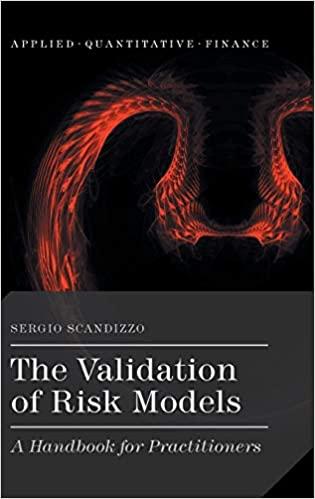Question
Investors, be they large corporations, banks, pension funds, mutual funds, or individuals, seldom hold a single financial asset; rather, they hold portfolios of financial assets.
Investors, be they large corporations, banks, pension funds, mutual funds, or individuals, seldom hold a single financial asset; rather, they hold portfolios of financial assets. Thus, the investor should be less concerned with the rate of return achieved by, say a particular stock in the portfolio than the overall rate of return of the portfolio.
Typically, an investor can choose from among many different assets to form a portfolio; in other words, there are many different portfolios from which an investor can choose. But which portfolio should the investor select? Since the future rate of return of a portfolio is uncertain a probability distribution can be used to characterize a portfolio's future rate of return. In particular, investment managers frequently characterize portfolios by the mean mu (expected value) and standard deviation sigma (risk) of their rates of return. First, the set of all possible portfolios - - the feasible set - - must be reduced to an efficient set of portfolios. An efficient portfolio is one that provides the highest possible mean rate of return for any given degree of risk (i.e., any given standard deviation sigma) or the lowest possible degree of risk (i.e., the lowest standard deviation sigma) for any given mean rate of return.
The attached graph (right click here and choose "Open Link in New Window" to see graph) shows the mean and standard deviation of the rate of return for various portfolios. Portfolios identified by a value of mu and sigma that fall within the ellipse represent the feasible set of portfolios for a particular investor. The efficient set of portfolios is denoted by the boundary arc ABC and is sometimes called the efficient frontier. Portfolios to the left of ABC are not attainable because they fall outside the feasible set. Portfolios to the right of ABC are not efficient because there always exists a portfolio that could provide (1) a higher mean return for a given level of standard deviation of returns (compare points B and D), or (2) a lower standard deviation (lower degree of risk) for a given mean rate of return (compare points B and E which have the same mean rate of return).
The future rates of return of stock portfolios X, Y, and Z can be characterized by the following probability distributions:
| STOCK PORTFOLIO X | |
| Rate of Return | Probability |
| .20 | .05 |
| .15 | .15 |
| .10 | .26 |
| .05 | .20 |
| .00 | .15 |
| -.05 | .10 |
| -.10 | .05 |
| -.15 | .03 |
| -.20 | .01 |
| STOCK PORTFOLIO Y | |
| Rate of Return | Probability |
| .15 | .10 |
| .10 | .20 |
| .05 | .30 |
| .00 | .20 |
| -.05 | .10 |
| -.10 | .07 |
| -.15 | .03 |
| STOCK PORTFOLIO Z | |
| Rate of Return | Probability |
| .25 | .05 |
| .20 | .10 |
| .15 | .25 |
| .10 | .20 |
| .05 | .15 |
| .00 | .10 |
| -.05 | .07 |
| -.10 | .05 |
| -.15 | .03 |
a. What is the probability of a negative rate of return if you invest in portfolio Y?
b. Find the expected rate of return of portfolio X.
.
c. Find the expected rate of return of portfolio Y.
.
d. Find the expected rate of return of portfolio Z.
.
Suppose you plot the mean and standard deviation for each of the portfolios X, Y, and Z on a graph like the one in the above link. Note that the standard deviation of the rate of return is on the horizontal axis and the expected rate of return is on the vertical axis. (DO NOT CALCULATE THE STANDARD DEVIATIONS! The standard deviations are as follows: portfolio X: .087155; portfolio Y: .074181; portfolio Z: .0966).
e. Below are statements about portfolios X, Y, and Z. Choose all the statements that are true. (This is a multiple-select problem; you must choose all the true statements to get the problem correct).
The overall pattern in the plot of the three portfolios is from lower left to upper right, meaning that portfolios with low risk have a high expected return.If you want to maximize your expected rate of return and are not concerned about risk, you would choose portfolio Z.The overall pattern in the plot of the three portfolios is from lower left to upper right, meaning that if you want a higher return you have to take more risk.An investor close to retirement who does not want to put her retirement nest egg at risk should invest in portfolio Z.Portfolio Y is for timid investors who want the least amount of risk.Portfolio X has more risk than portfolio Y.A young investor who wants more return and who is not very concerned about risk should choose portfolio Y over portfolio X.
Step by Step Solution
There are 3 Steps involved in it
Step: 1

Get Instant Access to Expert-Tailored Solutions
See step-by-step solutions with expert insights and AI powered tools for academic success
Step: 2

Step: 3

Ace Your Homework with AI
Get the answers you need in no time with our AI-driven, step-by-step assistance
Get Started


